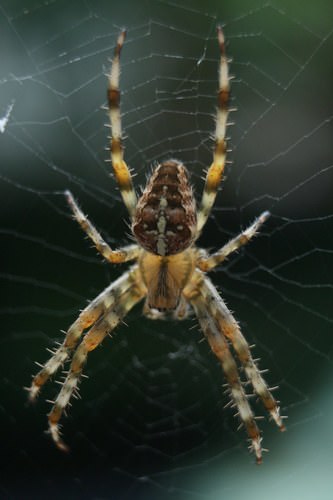8.1 动物行为
章节大纲
-
Why do spiders spin webs?
::为什么蜘蛛会旋转网络?You have probably seen a spider web before. You may even know that spiders create webs to catch their prey . This is an example of animal behavior. Animals have many different behaviors.
::你可能以前见过蜘蛛网。你甚至可能知道蜘蛛为捕捉猎物创造了网络。这是动物行为的例子。动物行为有许多不同的行为。Introduction to Animal Behavior
::动物行为介绍Barking, purring, and playing are just some of the ways in which dogs and cats behave. These are examples of animal behaviors. Animal behavior is any way that animals act, either alone or with other animals.
::狗和猫的行为举止只是狗和猫的一些行为方式。这些是动物行为的例子。动物行为是动物行为的任何方式,无论是单独还是与其他动物一起。Examples of Animal Behavior
::动物行为实例Can you think of examples of animal behaviors? What about and ? How do they behave? Pictured below are just some of the ways in which these, and other animals act ( Figure ). Look at the pictures and read about the behaviors. Think about why the animal is behaving that way.
::你能想象动物行为的例子吗?它们的行为如何?下面的图象只是动物行为和其他动物行为的一些方式(图)。看看这些图片和阅读有关动物行为的文章。想想为什么动物行为是这样的。These pictures show examples of animal behaviors. Why do the animals behave these ways?
::这些图片显示了动物行为的例子。为什么动物会这样?Importance of Animal Behavior
::动物行为的重要性Why do animals behave the way they do? The answer to this question depends on what the behavior is. A cat chases a mouse to catch it. A mother dog nurses her puppies to feed them. All of these behaviors have the same purpose: getting or providing food. All animals need food for energy . They need energy to move around. In fact, they need energy just to stay alive. Energy allows all the processes inside cells to occur. Baby animals also need energy to grow and develop.
::为什么动物的行为方式? 这个问题的答案取决于行为是什么。 一只猫追逐一只老鼠来捕捉它。 一只母狗喂养小狗喂养小狗。 所有这些行为的目的都是一样的: 获取或提供食物。 所有动物都需要食物作为能源。 它们需要能量来移动。 事实上, 它们需要能量来生存。 能量可以让细胞内的所有过程发生。 婴儿也需要能量来生长和发展。Birds and wasps build nests to have a safe place to store their eggs and raise their young. Many other animals build nests for the same reason. Animals protect their young in other ways, as well. For example, a mother dog not only nurses her puppies. She also washes them with her tongue and protects them from strange people or other animals. All of these behaviors help the young survive and grow up to be adults.
::鸟类 和 黄蜂 建立 巢穴 、 以 安全 的 地方 储存 卵 、 养育 幼鸟 。 许多其他 动物 也 以 相同 的 理由 建立 巢穴 。 动物 也 以 其它 方式 保护 幼鸟 。 例如 , 母狗 不仅 保护 小狗 、 也 用 舌头 洗 、 保护 其 不受 陌生 人 或其他 动物 的 伤害 。 所有这些 行为 都 帮助 年轻人 存活 、 长大成人 。Rabbits run away from foxes and other predators to stay alive. Their speed is their best defense. Lizards sun themselves on rocks to get warm because they cannot produce their own body heat. When they are warmer, they can move faster and be more alert. This helps them escape from predators and also find food.
::兔子逃离狐狸和其他捕食者而求生存。它们的速度是它们最好的防御手段。蜥蜴在岩石上晒太阳以取暖,因为它们不能产生自己的体温。当它们变暖时,它们可以更快地移动,更加警觉。这有助于它们逃离捕食者,找到食物。All of these animal behaviors are important. They help the animals get food for energy, make sure their young survive, or ensure that they, themselves, survive. Behaviors that help animals or their young survive, increase the animals’ fitness . Animals with higher fitness have a better chance of passing their genes on to the next generation. If genes control behaviors that increase fitness, the behaviors become more common in the species . This occurs through the process of evolution by .
::所有这些动物行为都很重要。 它们帮助动物获得食物以获取能量,确保它们的幼年生存,或确保它们自己生存。 帮助动物或幼年生存的行为会增加动物的体质。 健康程度较高的动物更有可能将其基因传给下一代。 如果基因控制着提高健康程度的行为,它们的行为就会在物种中变得更为常见。 这通过进化过程发生 。Summary
::摘要-
Animal behavior is any way that animals act, either alone or with other animals.
::动物行为是动物行为的任何方式, 无论是单独行动还是与其他动物一起行动。 -
Animal behavior may be aimed at getting food for energy, making sure their young survive, or ensuring that they, themselves, survive.
::动物行为的目的可能是获取食物以获取能量, 确保他们的年轻人生存下来, 或者确保他们自己生存下来。
Explore More
::探索更多Use the resources below to answer the questions that follow.
::利用以下资源回答以下问题。Explore More I
::探索更多-
Animal Behavior
at
(9:52)
:9:52)动物行为
-
When do animals learn innate behavior?
::动物什么时候学会天生的行为? -
Can you think of why "grasping" behavior would help human babies survive?
::你能想到为什么"割草"的行为 会帮助人类的婴儿生存吗? -
A crow vending machine is associated with what type of learning?
::乌鸦自动售卖机跟什么类型的学习有关? -
Compare and contrast "trial and error" learning and "observational" learning.
::比较和对比“审判和错误”学习和“观察”学习。 -
How do "mirror neurons" work?
::"美梦神经元"是怎么工作的?
Explore More II
::探索更多情况二-
Cnidarians: Anemone Swims Away From Sea Star
at
(2:01)
::克尼达里亚人:Anemone Swims 离开海星在(2:01)
-
What type of behavior do you think the sea anemone (
Stomphia coccinea
) is exhibiting? Explain your thinking fully and be specific.
::你认为海葵(Stomphia coccinea)展示什么行为?
Review
::回顾-
What are two examples of animal behaviors that are aimed at getting food?
::动物行为旨在获取食物的两个例子是什么? -
What are two examples of animal behaviors that are aimed at protecting the young?
::保护年轻人的动物行为有两个例子吗? -
What is meant by fitness? What is the relationship between animal behaviors and fitness?
::身体健康意味着什么?动物行为和身体健康之间的关系是什么? -
Is there a relationship between genes and fitness? Explain your answer.
::基因和健康之间有关系吗?
-
Animal behavior is any way that animals act, either alone or with other animals.

